HONDA PASSPORT 2001 2.G Owners Manual
Manufacturer: HONDA, Model Year: 2001, Model line: PASSPORT, Model: HONDA PASSPORT 2001 2.GPages: 317, PDF Size: 4.85 MB
Page 161 of 317

switc
h is turne d t o th e "ON "
o r "START " position .
5 . Chec k al l gauges (includin g
th e fue l gauge) .
6 . Release th e parkin g brak e
(an d mak e sur e th e "BRAKE "
ligh t turn s off) .
Se e relate d topic s i n thi s manua l i f
yo u fin d an y problems .
Startin g th e Engin e
1 . Appl y th e parkin g brake .
2 . Manual Transmission: Press
th e clutc h peda l t o th e floo r
an d shif t th e transmissio n t o
th e Neutra l position . Hol d th e
clutc h peda l t o th e floo r whil e
yo u ar e startin g th e engine . A
starte r safet y switc h keep s th e
starte r fro m operatin g i f th e
clutc h peda l i s no t full y
depressed .
Automatic
Transmission:
Plac e th e shif t leve r i n "P "
o r "N " positio n ("P " i s
preferred) . A starte r safet y
switc h prevent s th e starte r
fro m operatin g i f th e shif t
leve r i s i n an y driv e position .
I f i t i s necessary to restar t th e
engin e wit h th e vehicl e
moving , plac e th e shif t leve r
i n "N " (neve r i n "P") .
3 . D o no t touc h th e accelerato r
pedal . Star t th e engin e b y
turnin g th e ignitio n switc h t o
"START. "
I f th e engin e doe s no t star t i n
1 0 seconds , wai t 1 5 seconds to le t
th e starte r coo l down . The n cran k
th e engin e a t wid e ope n throttl e
fo r a maximu m o f 1 0 seconds . I f
th e engin e stil l doe s no t start , wai t
anothe r 1 5 seconds an d repeat th e
entir e procedure . D
o no t cran k th e engin e fo r mor e
tha n 1 0 second s a t a time . Wai t 1 5
second s befor e tryin g again .
4 . Retur n th e ignitio n switc h t o
th e "ON " positio n a s soo n a s
th e engin e starts .
5 . Appl y th e regula r brake s an d
shif t int o th e prope r gear .
Releas e th e parkin g brak e an d
brak e peda l an d driv e off .
I n model s wit h a n automati c
transmission , yo u canno t shif t
fro m "P " (Park ) positio n t o
an y othe r positio n unles s th e
brak e peda l i s applied .
Drivin g Tip s
Page 162 of 317
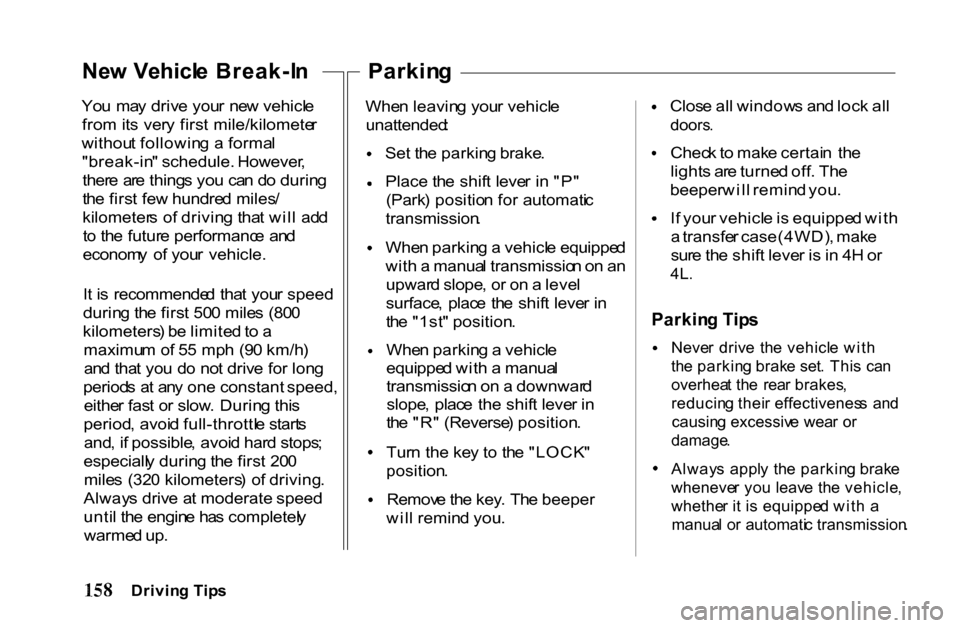
Yo
u ma y driv e you r ne w vehicl e
fro m its ver y firs t mile/kilomete r
withou t followin g a forma l
"break-in " schedule. However ,
ther e ar e thing s yo u ca n d o durin g
th e firs t fe w hundre d miles /
kilometer s o f drivin g tha t wil l ad d
t o th e futur e performanc e an d
econom y o f you r vehicle.
I t i s recommende d tha t you r speed
durin g th e firs t 50 0 mile s (80 0
kilometers ) b e limite d to a
maximu m o f 5 5 mp h (9 0 km/h )
an d tha t yo u d o no t driv e fo r lon g
period s a t an y one constant speed,
eithe r fas t o r slow . Durin g thi s
period , avoi d full-throttl e start s
and , i f possible , avoi d har d stops ;
especiall y durin g th e firs t 20 0
mile s (32 0 kilometers ) o f driving .
Alway s driv e a t moderate speed
unti l th e engin e ha s completel y
warme d up .
Parkin
g
Whe n leavin g you r vehicl e
unattended :
Set
th e parkin g brake . Place
th e shif t leve r i n "P "
(Park ) positio n fo r automati c
transmission .
Whe
n parkin g a vehicl e equippe d
wit h a manua l transmissio n o n a n
upwar d slope , o r o n a leve l
surface , plac e th e shif t leve r i n
th e "1st " position . Whe
n parkin g a vehicl e
equippe d wit h a manua l
transmissio n o n a downwar d
slope , plac e the shif t leve r i n
th e "R " (Reverse ) position . Tur
n the ke y t o th e "LOCK "
position .
Remov
e th e key . Th e beeper
wil l remin d you . Clos
e al l window s an d loc k al l
doors .
Chec
k to mak e certai n th e
light s ar e turne d off . Th e
beeper wil l remin d you . I
f you r vehicl e is equippe d wit h
a transfe r case (4WD) , mak e
sur e th e shif t leve r i s in 4 H o r
4L .
Parkin g Tip s
Neve
r driv e th e vehicl e wit h
th e parkin g brak e set . Thi s ca n
overhea t th e rea r brakes ,
reducin g thei r effectivenes s an d
causin g excessiv e wea r o r
damage .
Alway
s appl y th e parkin g brak e
wheneve r yo u leav e th e vehicle ,
whethe r i t i s equippe d wit h a
manua l o r automati c transmission .
Drivin g Tip s
Ne
w Vehicl e Break-I n
Page 163 of 317
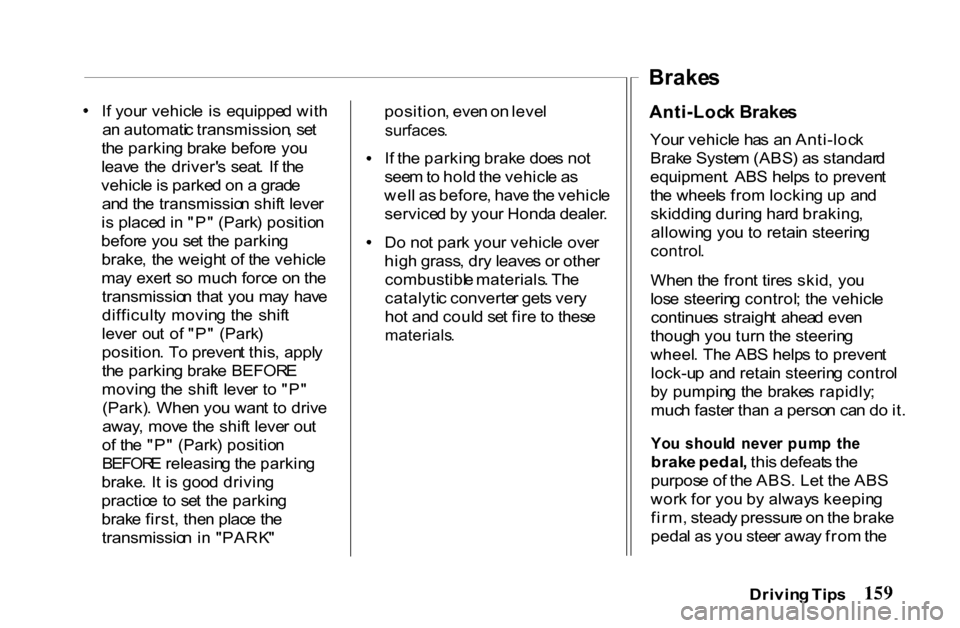
I
f you r vehicl e i s equippe d wit h
a n automati c transmission , se t
th e parkin g brak e befor e yo u
leav e th e driver' s seat . I f th e
vehicl e is parke d o n a grad e
an d th e transmissio n shif t leve r
i s place d in "P " (Park ) positio n
befor e yo u se t th e parkin g
brake , th e weigh t o f th e vehicl e
ma y exer t s o muc h forc e o n th e
transmissio n tha t yo u ma y hav e
difficult y movin g th e shif t
leve r ou t o f "P " (Park )
position . T o preven t this , appl y
th e parkin g brak e BEFOR E
movin g th e shif t leve r t o "P "
(Park) . Whe n yo u wan t t o driv e
away , mov e th e shif t leve r ou t
o f th e "P " (Park ) positio n
BEFOR E releasin g th e parkin g
brake . I t i s goo d drivin g
practic e t o se t th e parkin g
brak e first , the n plac e th e
transmissio n i n "PARK " position
, eve n o n leve l
surfaces .
I
f th e parkin g brak e doe s no t
see m to hol d th e vehicl e a s
wel l a s before , hav e th e vehicl e
service d b y you r Hond a dealer .
D o no t par k you r vehicl e ove r
hig h grass , dr y leave s o r othe r
combustibl e materials . Th e
catalyti c converte r get s ver y
ho t an d coul d se t fir e to thes e
materials .
Anti-Loc
k Brake s
You r vehicl e ha s a n Anti-loc k
Brak e Syste m (ABS ) a s standar d
equipment . AB S help s t o preven t
th e wheel s fro m lockin g u p an d
skiddin g durin g har d braking ,
allowin g yo u t o retai n steerin g
control .
Whe n th e fron t tire s skid , yo u
los e steerin g control ; th e vehicl e
continue s straigh t ahea d eve n
thoug h yo u tur n th e steerin g
wheel . Th e AB S help s t o preven t
lock-u p an d retai n steerin g contro l
b y pumpin g th e brake s rapidly ;
muc h faste r tha n a perso n ca n d o it .
Yo u shoul d neve r pum p th e
brak e pedal , thi s defeat s th e
purpos e o f th e ABS . Le t th e AB S
wor k fo r yo u b y alway s keepin g
firm , stead y pressur e o n th e brak e
peda l a s yo u stee r awa y fro m th e
Drivin g Tip s
Brake
s
Page 164 of 317
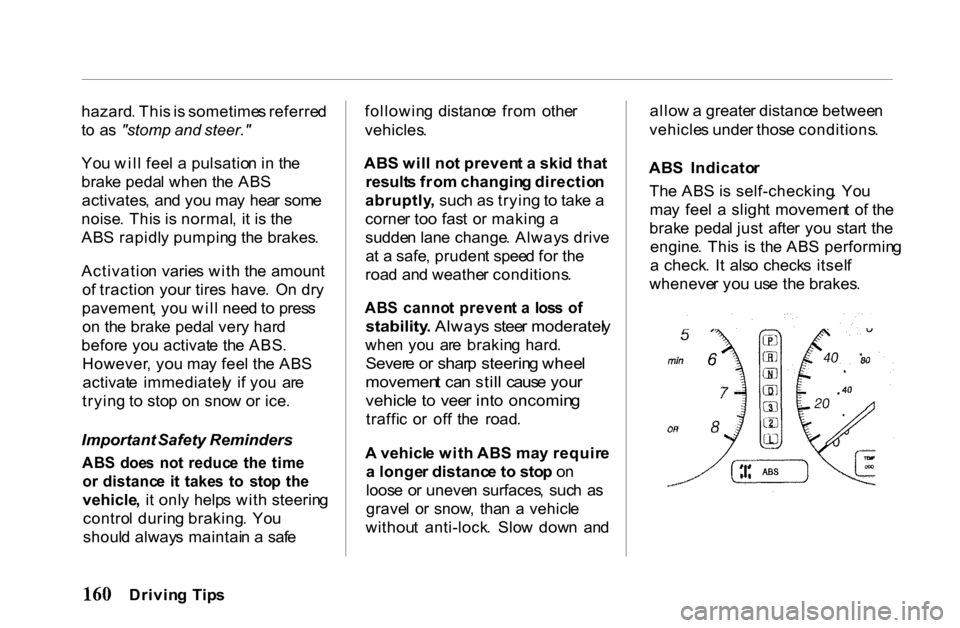
hazard
. Thi s is sometime s referre d
t o a s "stomp and steer."
Yo u wil l fee l a pulsatio n in th e
brak e peda l whe n th e AB S
activates , an d yo u ma y hea r som e
noise . Thi s i s normal , i t i s th e
AB S rapidl y pumpin g th e brakes .
Activatio n varie s wit h th e amount
o f tractio n you r tire s have . O n dr y
pavement , yo u wil l nee d to pres s
o n th e brak e peda l ver y har d
befor e yo u activat e th e ABS .
However , yo u ma y fee l th e AB S
activat e immediatel y i f yo u ar e
tryin g t o sto p o n sno w o r ice .
Important Safety Reminders
AB S doe s no t reduc e th e tim e
o r distanc e i t take s t o sto p th e
vehicle , i t onl y help s wit h steerin g
contro l durin g braking . Yo u
shoul d alway s maintai n a saf e followin
g distanc e fro m othe r
vehicles .
AB S wil l no t preven t a ski d tha t
result s fro m changin g directio n
abruptly , suc h a s tryin g to tak e a
corne r to o fas t o r makin g a
sudde n lan e change . Alway s driv e
a t a safe , pruden t spee d fo r th e
roa d an d weathe r conditions .
AB S canno t preven t a los s o f
stability . Alway s stee r moderatel y
whe n yo u ar e brakin g hard .
Sever e o r shar p steerin g whee l
movemen t ca n stil l caus e you r
vehicl e t o vee r int o oncomin g
traffi c o r of f th e road .
A vehicl e wit h AB S ma y requir e
a longe r distanc e t o sto p o n
loos e o r uneve n surfaces , suc h a s
grave l o r snow , tha n a vehicl e
withou t anti-lock . Slo w dow n an d allo
w a greate r distanc e betwee n
vehicle s unde r thos e conditions .
AB S Indicato r
Th e AB S is self-checking . Yo u
ma y fee l a sligh t movemen t o f th e
brak e peda l jus t afte r yo u star t th e
engine . Thi s i s th e AB S performin g
a check . I t als o check s itsel f
wheneve r yo u us e th e brakes .
Drivin g Tip s
Page 165 of 317

I
f anythin g goe s wrong , th e AB S
indicato r o n th e instrumen t pane l
come s o n (se e pag e 67 ). Thi s
mean s th e anti-loc k functio n of
th e brakin g syste m ha s shu t down .
Th e brake s stil l wor k lik e a
conventiona l syste m withou t
anti-lock , providin g norma l
stoppin g ability . Yo u shoul d hav e
th e deale r inspec t you r vehicl e a s
soo n a s possibl e i f thi s ligh t stay s
o n afte r yo u star t th e engine , o r
come s o n whil e driving .
Drivin
g Wit h We t Brake s
Drivin g throug h dee p wate r ma y
ge t th e brake s we t an d reduc e
thei r effectiveness . A s a result , th e
vehicl e ma y no t slo w dow n
normall y o r ma y pul l i n on e
directio n o r th e other .
I f yo u driv e throug h dee p water ,
appl y th e brake s lightl y t o se e i f
th e wate r ha s affecte d them . T o
dr y th e brake s quickly , pres s
lightl y o n th e brak e peda l whil e
maintainin g th e sam e spee d wit h
th e accelerato r pedal . Continu e
thi s unti l th e brake s operat e
normally .
Powe
r Brake s
Th e brakin g syste m use s engin e
vacuu m to provid e powe r assist . I f
th e powe r assis t fail s becaus e o f a
stalle d engin e o r othe r reason , th e
reserv e vacuu m in th e syste m wil l
usuall y allo w yo u t o appl y th e
brake s a t leas t on e time .
Th e reserv e vacuu m is partl y use d
u p eac h tim e th e brak e peda l i s
applie d an d released . D o no t
pum p th e brake s whe n th e powe r
assis t ha s bee n lost , excep t whe n
neede d t o maintai n steerin g
contro l o n slipper y surfaces .
Yo u ca n stil l sto p th e vehicl e
withou t th e powe r assis t b y pushin g
harde r o n th e brak e pedal .
However , th e stoppin g distanc e
ma y b e longer , eve n thoug h th e
brake s themselve s remai n full y
operational .
Drivin g Tip s
Page 166 of 317

Self-Adjustin
g Brake s
Th e brake s o n thi s vehicl e ar e
self-adjusting . The y hav e bee n
designe d s o tha t periodi c brak e
adjustmen t i s no t needed .
Th e brakes adjus t themselve s eac h
tim e yo u firml y appl y them .
Thus , i f th e brak e peda l goe s dow n
farthe r tha n norma l du e t o a lac k o f
adjustment , driv e backwar d an d
forwar d a fe w times . Appl y th e
brake s intermittently .
Se e you r Hond a deale r i f th e
brak e peda l heigh t doe s no t retur n
t o norma l o r i f ther e i s a rapi d
increas e i n peda l travel . Eithe r i s a
sig n o f othe r brak e trouble . Also ,
se e you r Hond a deale r i f th e
parkin g brak e needs adjustment .
Brakin
g Tip s
Contro l you r vehicle' s spee d o n a
stee p o r lon g downhil l grad e b y
shiftin g th e transmissio n t o a
lowe r gear . Constantl y usin g th e
brake s ca n caus e the m to overhea t
an d los e effectiveness .
Restin g you r foo t o n th e brak e
peda l whe n yo u ar e no t intendin g
t o brak e ("ridin g th e brakes" ) ca n
caus e the m to overheat . Thi s
reduce s thei r effectiveness, wears
the m ou t faster , an d ca n reduc e
fue l mileage . I t als o causes you r
brak e light s t o sta y o n al l th e time ,
confusin g driver s behin d you .
Brak e Wea r Indicator s
Th e fron t an d rea r brake s hav e
built-i n wea r indicators . Thes e mak
e a high-pitche d squealin g o r
cricket-lik e warnin g soun d whe n
th e brak e pad s o r lining s ar e wor n
t o th e poin t o f replacement . Th e
soun d ma y com e an d g o o r b e
hear d al l th e tim e whe n th e vehicl e
i s moving , bu t ma y sto p whe n th e
brak e peda l i s pushe d dow n firmly .
Expensiv e damag e ca n resul t i f
pad s o r lining s ar e no t replace d
immediatel y whe n needed .
Drivin g o n Slipper y Surface s
Driving , steering , an d brakin g
tractio n ar e reduce d whe n th e
roa d is coate d wit h water , snow ,
ice , gravel , o r othe r materials .
Slo w dow n an d adjus t you r
drivin g t o suc h conditions . I t i s
importan t t o slo w dow n whe n i t i s
slipper y because stoppin g
Drivin g Tip s
Page 167 of 317
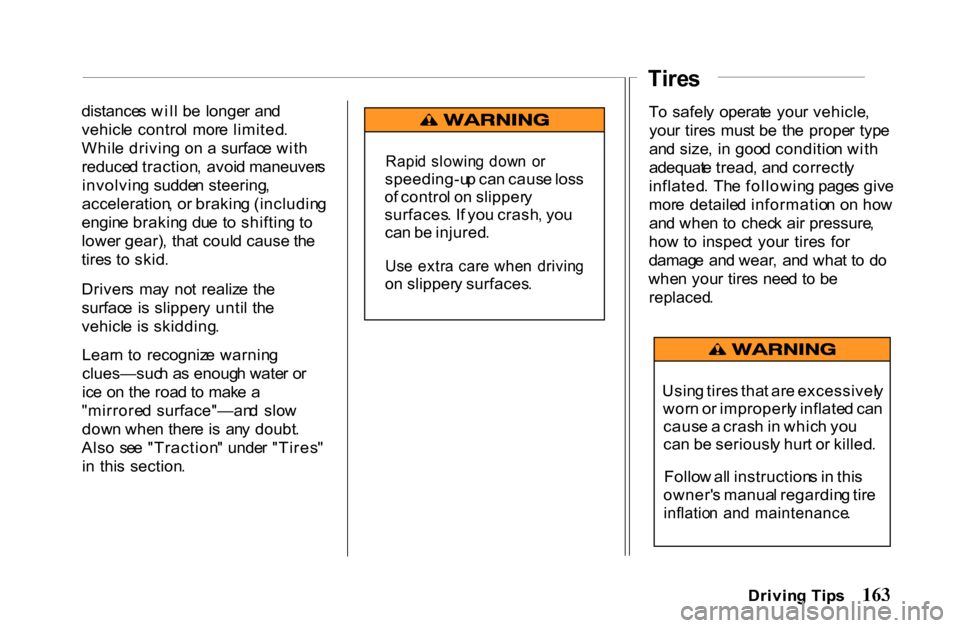
distance
s wil l b e longe r an d
vehicl e contro l mor e limited .
Whil e drivin g o n a surfac e wit h
reduce d traction , avoi d maneuver s
involvin g sudde n steering ,
acceleration , o r brakin g (includin g
engin e brakin g du e t o shiftin g t o
lowe r gear) , tha t coul d cause th e
tire s t o skid .
Driver s ma y no t realiz e th e
surfac e i s slipper y unti l th e
vehicl e i s skidding .
Lear n t o recogniz e warnin g
clues—suc h a s enoug h wate r o r
ic e o n th e roa d to mak e a
"mirrore d surface"—an d slo w
dow n whe n ther e is an y doubt .
Als o se e "Traction " unde r "Tires "
i n thi s section . T
o safel y operat e you r vehicle ,
you r tire s mus t b e th e prope r typ e
an d size , i n goo d conditio n wit h
adequat e tread , an d correctl y
inflated . Th e followin g page s giv e
mor e detaile d informatio n o n ho w
an d whe n t o chec k ai r pressure ,
ho w to inspec t you r tire s fo r
damag e an d wear , an d wha t t o d o
whe n you r tire s nee d t o b e
replaced .
Drivin g Tip s
Rapi
d slowin g dow n o r
speeding-u p ca n caus e los s
o f contro l o n slipper y
surfaces . I f yo u crash , yo u
ca n b e injured .
Us e extr a car e whe n drivin g
o n slipper y surfaces .
Using tire s tha t ar e excessivel y
wor n o r improperl y inflate d ca n
caus e a cras h in whic h yo u
ca n b e seriousl y hur t o r killed .
Follo w al l instruction s in thi s
owner' s manua l regardin g tir e
inflatio n an d maintenance .
Tire
s
Page 168 of 317
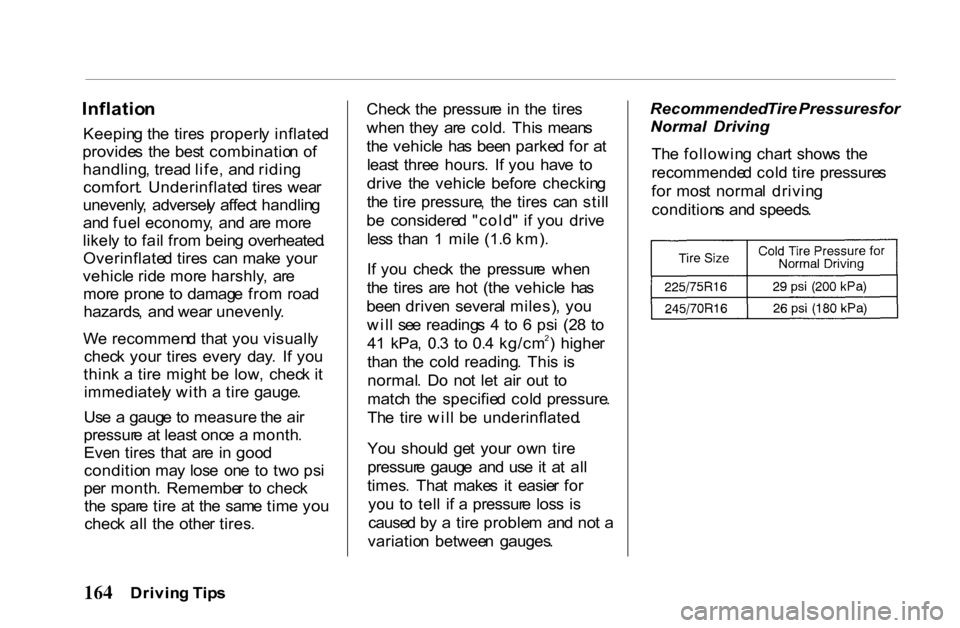
Inflatio
n
Keepin g th e tire s properl y inflate d
provide s th e bes t combinatio n o f
handling , trea d life , an d ridin g
comfort . Underinflate d tire s wea r
unevenly , adversel y affec t handlin g
an d fue l economy , an d ar e mor e
likel y t o fai l fro m bein g overheated .
Overinflate d tire s ca n mak e you r
vehicl e rid e mor e harshly , ar e
mor e pron e t o damag e fro m roa d
hazards , an d wea r unevenly .
W e recommen d tha t yo u visuall y
chec k you r tire s ever y day . I f yo u
thin k a tir e migh t b e low , chec k i t
immediatel y wit h a tir e gauge .
Us e a gaug e t o measure th e ai r
pressur e a t leas t onc e a month .
Eve n tire s tha t ar e i n goo d
conditio n ma y los e on e t o tw o ps i
pe r month . Remembe r t o chec k
th e spar e tir e a t th e sam e tim e yo u
chec k al l th e othe r tires . Chec
k th e pressur e i n th e tire s
whe n the y ar e cold . Thi s mean s
th e vehicl e ha s bee n parke d fo r a t
leas t thre e hours . I f yo u hav e t o
driv e th e vehicl e befor e checkin g
th e tir e pressure , th e tire s ca n stil l
b e considere d "cold " i f yo u driv e
les s tha n 1 mil e (1. 6 km) .
I f yo u chec k th e pressur e whe n
th e tire s ar e ho t (th e vehicl e ha s
bee n drive n severa l miles) , yo u
wil l se e reading s 4 to 6 ps i (2 8 t o
4 1 kPa , 0. 3 t o 0. 4 kg/cm 2) highe r
tha n th e col d reading . Thi s i s
normal . D o no t le t ai r ou t t o
matc h th e specifie d col d pressure .
Th e tir e wil l b e underinflated .
Yo u shoul d ge t you r ow n tir e
pressur e gaug e an d us e it a t al l
times . Tha t make s i t easie r fo r
yo u t o tel l i f a pressur e los s i s
cause d b y a tir e proble m an d no t a
variatio n betwee n gauges .
Recommended
Tire Pressures for
Normal Driving
Th e followin g char t show s th e
recommende d col d tir e pressure s
fo r mos t norma l drivin g
condition s an d speeds .
Drivin g Tip s
Page 169 of 317
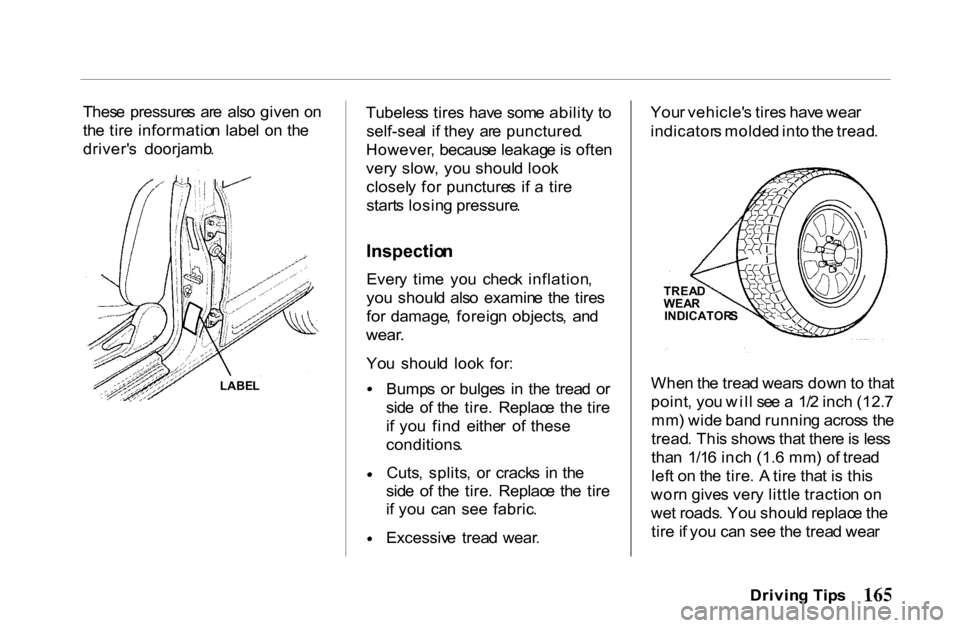
Thes
e pressure s ar e als o give n o n
th e tir e informatio n labe l o n th e
driver' s doorjamb . Tubeles
s tire s hav e som e abilit y t o
self-sea l i f the y ar e punctured .
However , becaus e leakag e is ofte n
ver y slow , yo u shoul d loo k
closel y fo r puncture s i f a tir e
start s losin g pressure .
Inspectio n
Ever y tim e yo u chec k inflation ,
yo u shoul d als o examin e th e tire s
fo r damage , foreig n objects , an d
wear .
Yo u shoul d loo k for : Bump
s o r bulge s i n th e trea d o r
sid e o f th e tire . Replac e the tir e
i f yo u fin d eithe r o f these
conditions . Cuts
, splits , o r crack s i n th e
sid e o f th e tire . Replac e th e tir e
i f yo u ca n see fabric . Excessiv
e trea d wear . You
r vehicle' s tire s hav e wea r
indicator s molde d int o th e tread .
Whe n th e trea d wear s dow n to tha t
point , yo u wil l se e a 1/ 2 inc h (12. 7
mm ) wid e ban d runnin g acros s th e
tread . Thi s show s tha t ther e is les s
tha n 1/1 6 inc h (1. 6 mm ) o f trea d
lef t o n th e tire . A tir e tha t i s thi s
wor n give s ver y littl e tractio n o n
we t roads . Yo u shoul d replac e th e
tir e if yo u ca n see th e trea d wea r
Drivin g Tip s
LABE
L TREA
D
WEA R
INDICATOR S
Page 170 of 317
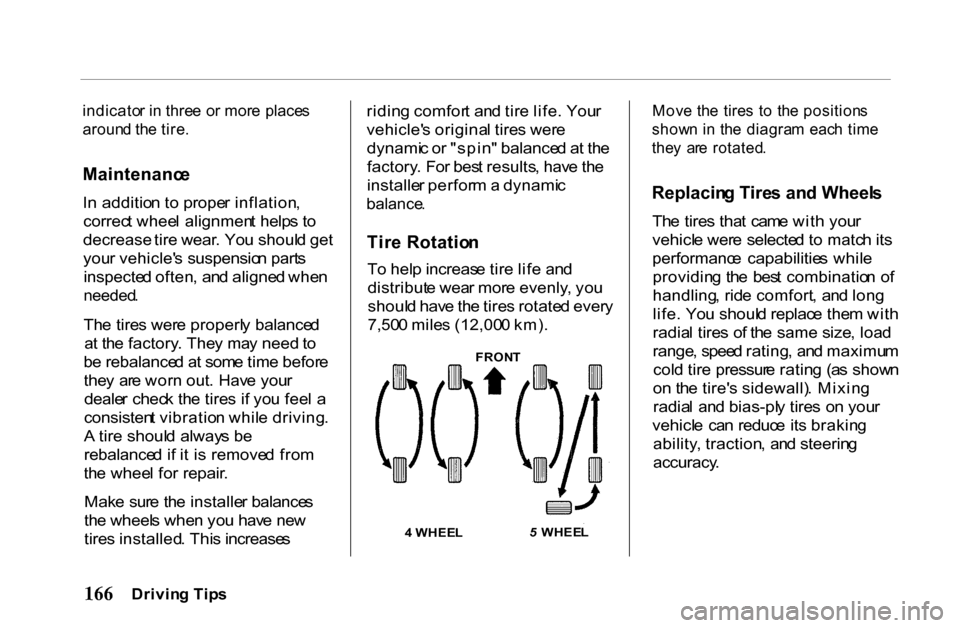
indicato
r i n thre e o r mor e place s
aroun d th e tire .
Maintenanc e
I n additio n t o prope r inflation ,
correc t whee l alignmen t help s t o
decrease tir e wear . Yo u shoul d get
you r vehicle' s suspensio n part s
inspecte d often , an d aligne d whe n
needed .
Th e tire s wer e properl y balance d
a t th e factory . The y ma y need to
b e rebalance d a t som e tim e befor e
the y ar e wor n out . Hav e you r
deale r chec k th e tire s i f yo u fee l a
consisten t vibratio n whil e driving .
A tir e shoul d alway s b e
rebalance d i f i t i s remove d fro m
th e whee l fo r repair .
Mak e sur e th e installe r balance s
th e wheel s whe n yo u hav e ne w
tire s installed . Thi s increase s ridin
g comfor t an d tir e life . You r
vehicle' s origina l tire s wer e
dynami c o r "spin " balance d a t th e
factory . Fo r bes t results , hav e th e
installe r perfor m a dynami c
balance .
Tir e Rotatio n
T o hel p increas e tir e lif e an d
distribut e wea r mor e evenly , yo u
shoul d hav e th e tire s rotate d ever y
7,50 0 mile s (12,00 0 km) .
Mov
e th e tire s t o th e position s
show n i n th e diagra m eac h tim e
the y ar e rotated .
Replacin g Tire s an d Wheel s
Th e tire s tha t cam e wit h you r
vehicl e wer e selecte d t o matc h it s
performanc e capabilitie s whil e
providin g th e bes t combinatio n o f
handling , rid e comfort , an d lon g
life . Yo u shoul d replac e the m wit h
radia l tire s o f th e same size , loa d
range , spee d rating , an d maximu m
col d tir e pressur e ratin g (a s show n
o n th e tire' s sidewall) . Mixin g
radia l an d bias-pl y tire s o n you r
vehicl e ca n reduc e it s brakin g
ability , traction , an d steerin g
accuracy .
Drivin g Tip s
FRON
T
5 WHEE L
4 WHEE L